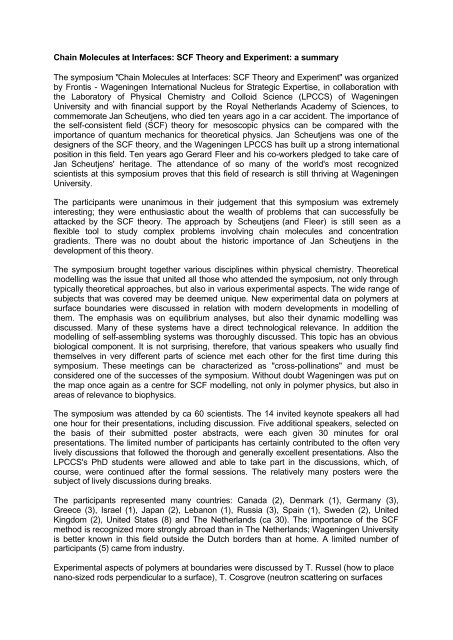Collapse of polymer brushes grafted onto planar ... - Wageningen UR
Collapse of polymer brushes grafted onto planar ... - Wageningen UR
Collapse of polymer brushes grafted onto planar ... - Wageningen UR
Create successful ePaper yourself
Turn your PDF publications into a flip-book with our unique Google optimized e-Paper software.
Chain Molecules at Interfaces: SCF Theory and Experiment: a summary<br />
The symposium "Chain Molecules at Interfaces: SCF Theory and Experiment" was organized<br />
by Frontis - <strong>Wageningen</strong> International Nucleus for Strategic Expertise, in collaboration with<br />
the Laboratory <strong>of</strong> Physical Chemistry and Colloid Science (LPCCS) <strong>of</strong> <strong>Wageningen</strong><br />
University and with financial support by the Royal Netherlands Academy <strong>of</strong> Sciences, to<br />
commemorate Jan Scheutjens, who died ten years ago in a car accident. The importance <strong>of</strong><br />
the self-consistent field (SCF) theory for mesoscopic physics can be compared with the<br />
importance <strong>of</strong> quantum mechanics for theoretical physics. Jan Scheutjens was one <strong>of</strong> the<br />
designers <strong>of</strong> the SCF theory, and the <strong>Wageningen</strong> LPCCS has built up a strong international<br />
position in this field. Ten years ago Gerard Fleer and his co-workers pledged to take care <strong>of</strong><br />
Jan Scheutjens' heritage. The attendance <strong>of</strong> so many <strong>of</strong> the world's most recognized<br />
scientists at this symposium proves that this field <strong>of</strong> research is still thriving at <strong>Wageningen</strong><br />
University.<br />
The participants were unanimous in their judgement that this symposium was extremely<br />
interesting; they were enthusiastic about the wealth <strong>of</strong> problems that can successfully be<br />
attacked by the SCF theory. The approach by Scheutjens (and Fleer) is still seen as a<br />
flexible tool to study complex problems involving chain molecules and concentration<br />
gradients. There was no doubt about the historic importance <strong>of</strong> Jan Scheutjens in the<br />
development <strong>of</strong> this theory.<br />
The symposium brought together various disciplines within physical chemistry. Theoretical<br />
modelling was the issue that united all those who attended the symposium, not only through<br />
typically theoretical approaches, but also in various experimental aspects. The wide range <strong>of</strong><br />
subjects that was covered may be deemed unique. New experimental data on <strong>polymer</strong>s at<br />
surface boundaries were discussed in relation with modern developments in modelling <strong>of</strong><br />
them. The emphasis was on equilibrium analyses, but also their dynamic modelling was<br />
discussed. Many <strong>of</strong> these systems have a direct technological relevance. In addition the<br />
modelling <strong>of</strong> self-assembling systems was thoroughly discussed. This topic has an obvious<br />
biological component. It is not surprising, therefore, that various speakers who usually find<br />
themselves in very different parts <strong>of</strong> science met each other for the first time during this<br />
symposium. These meetings can be characterized as "cross-pollinations" and must be<br />
considered one <strong>of</strong> the successes <strong>of</strong> the symposium. Without doubt <strong>Wageningen</strong> was put on<br />
the map once again as a centre for SCF modelling, not only in <strong>polymer</strong> physics, but also in<br />
areas <strong>of</strong> relevance to biophysics.<br />
The symposium was attended by ca 60 scientists. The 14 invited keynote speakers all had<br />
one hour for their presentations, including discussion. Five additional speakers, selected on<br />
the basis <strong>of</strong> their submitted poster abstracts, were each given 30 minutes for oral<br />
presentations. The limited number <strong>of</strong> participants has certainly contributed to the <strong>of</strong>ten very<br />
lively discussions that followed the thorough and generally excellent presentations. Also the<br />
LPCCS's PhD students were allowed and able to take part in the discussions, which, <strong>of</strong><br />
course, were continued after the formal sessions. The relatively many posters were the<br />
subject <strong>of</strong> lively discussions during breaks.<br />
The participants represented many countries: Canada (2), Denmark (1), Germany (3),<br />
Greece (3), Israel (1), Japan (2), Lebanon (1), Russia (3), Spain (1), Sweden (2), United<br />
Kingdom (2), United States (8) and The Netherlands (ca 30). The importance <strong>of</strong> the SCF<br />
method is recognized more strongly abroad than in The Netherlands; <strong>Wageningen</strong> University<br />
is better known in this field outside the Dutch borders than at home. A limited number <strong>of</strong><br />
participants (5) came from industry.<br />
Experimental aspects <strong>of</strong> <strong>polymer</strong>s at boundaries were discussed by T. Russel (how to place<br />
nano-sized rods perpendicular to a surface), T. Cosgrove (neutron scattering on surfaces

















